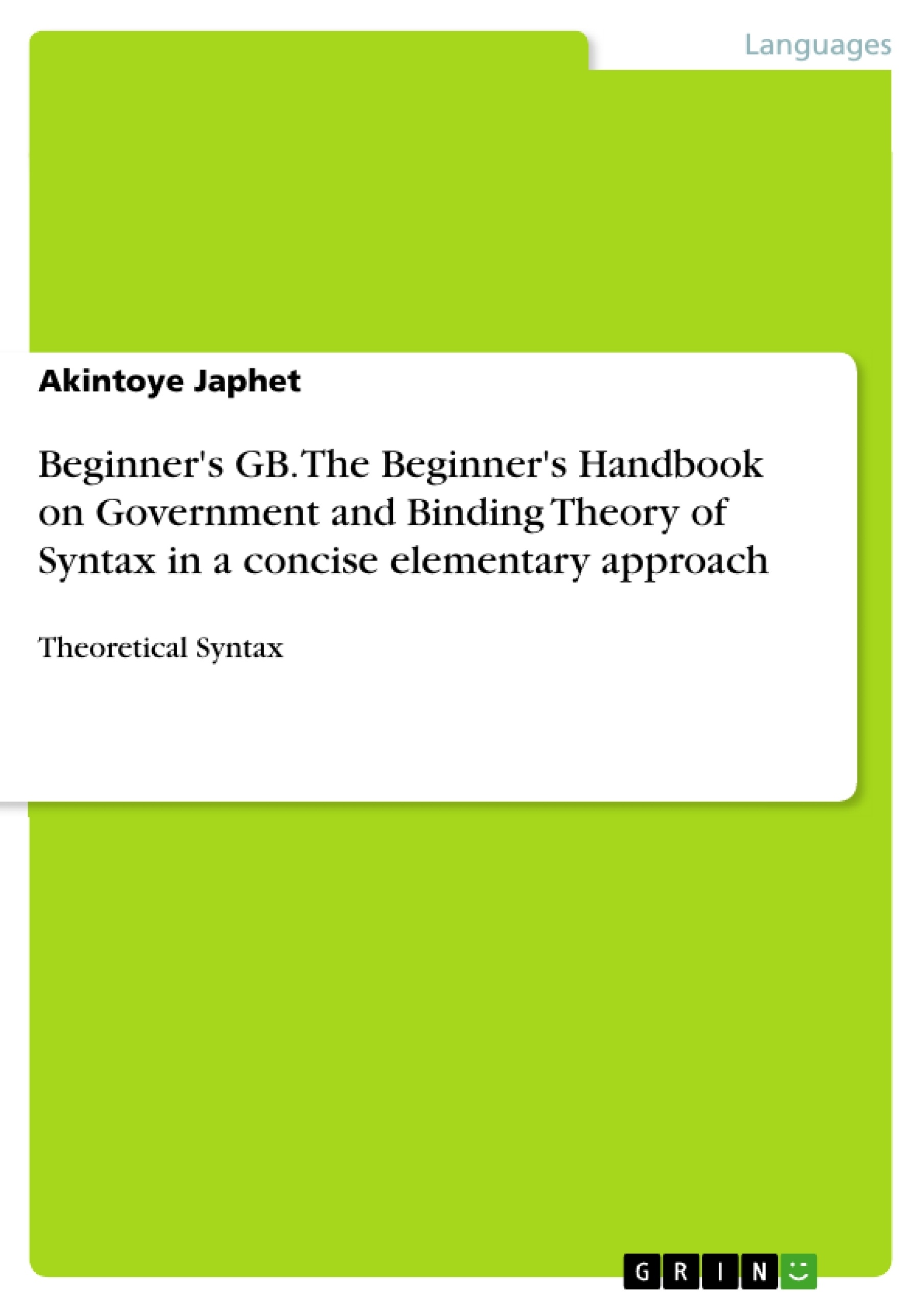Government and Binding Theory is as simple as the approached used in teaching it. Due to the conventions of its framework, some of the good texts on the theory are often too difficult for average linguistics readers especially those that are not in the syntax sub-field. This book is therefore written to remove some of the barriers that hinder beginners from developing interest in the theory.
The book does not give detailed discussion. This is deliberate in order to prevent beginners from being scared. Therefore, the text is expected to be read in a very short time. During this period, readers should be able to have an overview of the theory. Some exercises were also provided for regular assessments.
Attempting those exercises will expose readers to some basic operations in the theory. Although, those questions may not require accurate answers; however, readers should attempt them even when the answers provided do not seem to be correct.
This text differs from other introductory texts in GB. First, it is not as detailed as other introductory texts written for GB. Second, it is easier to understand. Third, it is written for people who might not have had any strong grip of the theory. Therefore, this book should be seen as a starter pack for students before they will even be competent to read the well-known introductory texts. The focus on the basic terms may look too simple for people that are already acquainted with the theory since can easily use some of the popular introductory texts. However, this text can still be recommended to students by lecturers who want them to have a broad overview of the theoretical aspect before going deep into the data-driven aspect being used in natural language analysis.
Table of Contents
- GENERAL INTRODUCTION
- 1. X-BAR THEORY
- 1.1 PROJECTION PRINCIPLE.
- 1.2 X-BAR: THE INTERMEDIATE CATEGORY
- 1.3 PHRASE STRUCTURE PARAMETERS.
- 1.4 FUNCTIONAL PROJECTIONS OF THE SENTENCE AS A PHRASE (THE IP AND THE CP).....
- 1.5 OTHER FUNCTIONAL PHRASES
- 1.5.1 Determiner Phrase (DP).
- 1.5.2 Tense Phrase...
- 1.5.3 Agreement Phrases..
- 2. THETA THEORY.
- 2.0 INTRODUCTION.
- 2.1 ARGUMENTS.
- 2.2 THETA ROLE ASSIGNMENT.
- 2.3 THETA AND MOVEMENT OF ARGUMENTS
- 3. CASE THEORY
- 3.0 INTRODUCTION...
- 3.1 ABSTRACT CASE.
- 3.2 STRUCTURAL CASE.
- 3.3 CASE ASSIGNMENT.
- 4. GOVERNMENT THEORY.
- 4.0 INTRODUCTION.
- 4.1 INTERACTIONS BETWEEN GOVERNMENT AND CASE THEORIES
- 4.2 INFLECTION AS A GOVERNOR.
- 4.3 'SMALL CLAUSES'.
- 5. BINDING THEORY.
- 5.0 INTRODUCTION...
- 5.1 THE THREE PRINCIPLES.
- 5.2 PRO AS AN NP
- 6. CONTROL THEORY.
- 6.0 INTRODUCTION..
- 6.1 ARBITRARY CONTROL.
- 6.2 OBLIGATORY CONTROL ..
- 6.3 OPTIONAL CONTROL.
- 6.4 SUBJECT CONTROL AND OBJECT CONTROL...
- 7. BOUNDING THEORY
- 7.0 INTRODUCTION..
- 7.1 NP MOVEMENT.
- 7.2 PASSIVE AND RAISING CONSTRUCTIONS.
- 7.3 ERGATIVE CONSTRUCTION.
- 7.4 APPLICATION OF BINDING THEORY TO THE NP TRACE
- 7.5 WH-MOVEMENT.
- 7.6 CONSTRAINTS FOR WH- MOVEMENT
- 7.6.1 THAT-TRACE FILTER
- 7.6.2 ISLAND CONSTRAINT.
- 7.7 WH-TRACE AND THE BINDING THEORY
- 7.8 CROSSOVER EFFECT.
- 8. SHORT CHAPTER-BY-CHAPTER REVIEW EXERCISES
- REFERENCES AND FURTHER READINGS..
Objectives and Key Themes
This handbook aims to provide a clear and concise introduction to Government and Binding Theory, a significant framework within Transformational Generative Grammar. The text explores core principles and concepts that govern natural language, enabling readers to understand the fundamental structures and rules of syntax.
- Universal Grammar principles and their variations across languages
- The role of word order in phrase structure and head-projection
- Theories of phrase structure, argument structure, and case assignment
- Government and Binding Theory's role in explaining syntactic phenomena like movement and binding
- The application of these principles to understand real-world language use
Chapter Summaries
The text begins with an overview of the core principles of Government and Binding Theory, highlighting its position within Transformational Generative Grammar. It then delves into the X-Bar Theory, exploring the concept of projection and the role of functional projections in sentence structure. The subsequent chapters examine Theta Theory, Case Theory, and Government Theory, providing a comprehensive understanding of argument structure, case assignment, and the relationship between these theories.
The text then moves on to Binding Theory, explaining the three principles that govern anaphora and pronominalization. Control Theory is explored next, examining different types of control structures and their implications for sentence interpretation. The final chapter focuses on Bounding Theory, analyzing the constraints on movement and the interaction between movement and Binding Theory.
Keywords
Key terms and concepts addressed in this text include: Government and Binding Theory, Universal Grammar, X-Bar Theory, Projection Principle, Theta Theory, Case Theory, Government Theory, Binding Theory, Control Theory, Bounding Theory, Phrase Structure, Argument Structure, Case Assignment, Movement, Anaphora, Pronominalization, and Constraints.
- Citar trabajo
- Akintoye Japhet (Autor), 2015, Beginner's GB. The Beginner's Handbook on Government and Binding Theory of Syntax in a concise elementary approach, Múnich, GRIN Verlag, https://www.grin.com/document/304136




